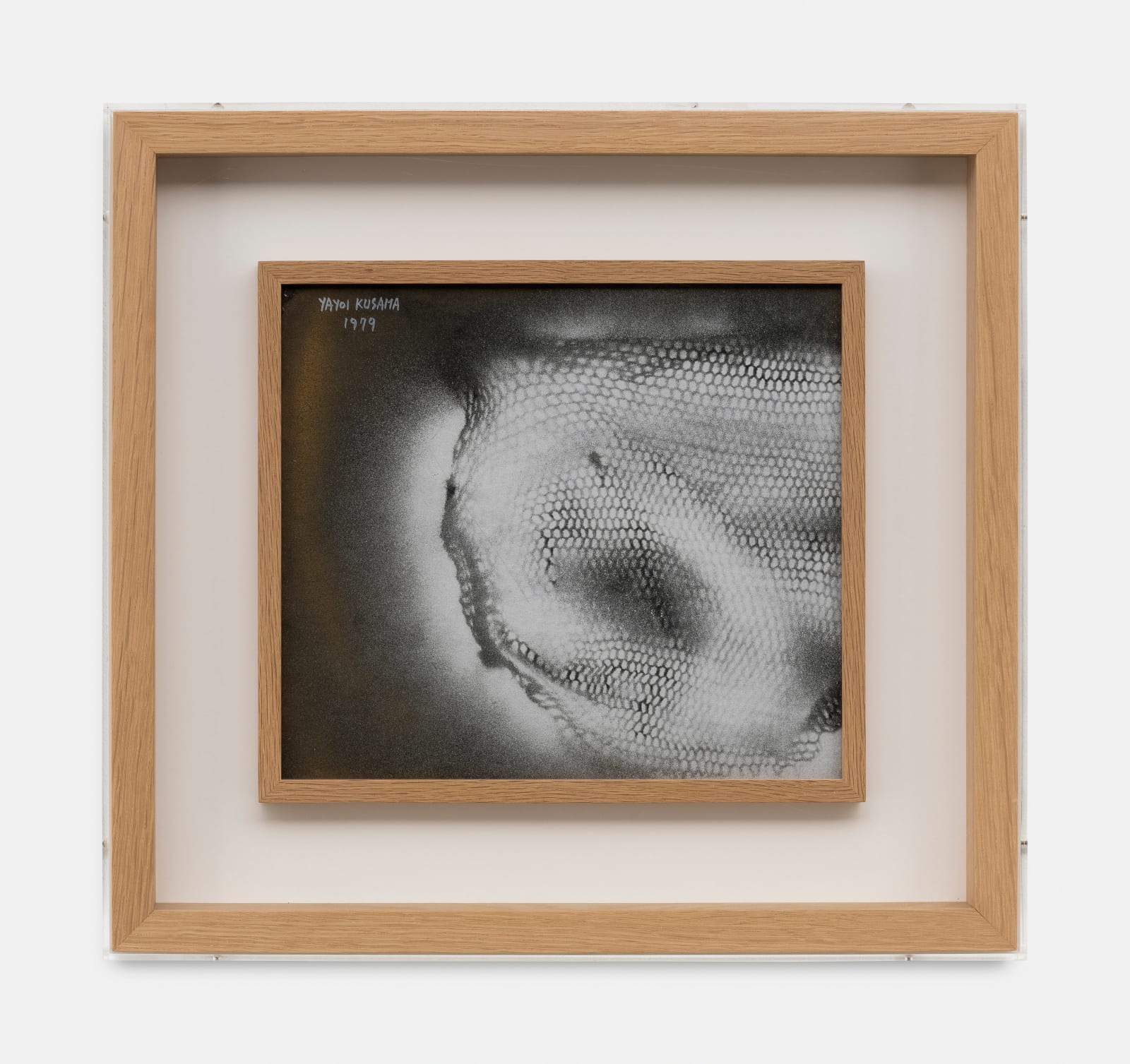
Yayoi Kusama
Butterfly Wing, 1979
spray paint on Shikishi board
Accompanied by the original Kusama studio card No.04023.
Accompanied by the original Kusama studio card No.04023.
24.1 x 26.7 cm
9 1/2 x 10 1/2 in
9 1/2 x 10 1/2 in
Copyright The Artist
The recurring motif of a net takes on various forms throughout Yayoi Kusama's career, manifesting as a delicately painted lace-like pattern, a tangible overlay on artworks, and, in the adjacent...
The recurring motif of a net takes on various forms throughout Yayoi Kusama's career, manifesting as a delicately painted lace-like pattern, a tangible overlay on artworks, and, in the adjacent piece, a shadowy image produced through spray paint on board. These works revisit Kusama's typical compositional structure, featuring a figurative oval set against an abstract backdrop with randomly scattered dots. In this instance, the netting introduces a heightened sense of three-dimensionality through its gathering and folding around the perimeter—a departure from Kusama's previous exploration in painted works. This virtual depth is complemented by the tangible relief of raised and erupting red dots, concealed beneath layers of black and spray paint.
Yayoi Kusama (b. 1929 in Matsumoto, Japan) is one of the most renowned Japanese artists of her generation. Though widely cherished for her contemporary, room-sized installations and expansive Infinity Mirror Rooms, Kusama has been actively creating art for around eight decades, exploring diverse mediums such as works on paper, large abstract paintings, soft sculpture, immersive environments, thought-provoking performances, mixed-media pieces, outdoor sculptures, and literary pursuits. She has extensively reflected on her art, describing it as "obsessive," serving as a means to cope with, express, and transcend profound anxieties. A poignant late 1980s poem by Kusama expresses her longing to break through the metaphorical curtain, return to earthly realities, and "open the shape called love." This poetic sentiment serves as the exhibition's motto, emphasizing Kusama's inclusive and expansive artistic vision, the formative decisions in her work, and the ultimate aspiration for a love that she envisions as a liberating dissolution of self—a positive form of death.
Her works are in museum collections worldwide including the Centre Georges Pompidou, Paris, Los Angeles County Museum of Art, Los Angeles, MoMA, New York, National Museum of Modern Art, Tokyo, Stedelijk Museum, Amsterdam, Tate, London, and the Whitney Museum of American Art, New York among many others.
Yayoi Kusama (b. 1929 in Matsumoto, Japan) is one of the most renowned Japanese artists of her generation. Though widely cherished for her contemporary, room-sized installations and expansive Infinity Mirror Rooms, Kusama has been actively creating art for around eight decades, exploring diverse mediums such as works on paper, large abstract paintings, soft sculpture, immersive environments, thought-provoking performances, mixed-media pieces, outdoor sculptures, and literary pursuits. She has extensively reflected on her art, describing it as "obsessive," serving as a means to cope with, express, and transcend profound anxieties. A poignant late 1980s poem by Kusama expresses her longing to break through the metaphorical curtain, return to earthly realities, and "open the shape called love." This poetic sentiment serves as the exhibition's motto, emphasizing Kusama's inclusive and expansive artistic vision, the formative decisions in her work, and the ultimate aspiration for a love that she envisions as a liberating dissolution of self—a positive form of death.
Her works are in museum collections worldwide including the Centre Georges Pompidou, Paris, Los Angeles County Museum of Art, Los Angeles, MoMA, New York, National Museum of Modern Art, Tokyo, Stedelijk Museum, Amsterdam, Tate, London, and the Whitney Museum of American Art, New York among many others.
Provenance
Atsuko Murayama Fine Art, New York
Private Collection, Belgium
Join our mailing list
* denotes required fields
In order to respond to your enquiry, we will process the personal data you have supplied to communicate with you in accordance with our Privacy Policy. You can unsubscribe or change your preferences at any time by clicking the link in our emails. This site is protected by reCAPTCHA and the Google: Privacy Policy and Terms of Service apply.